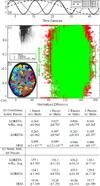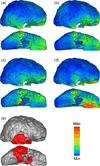Dynamic Electrical Source Imaging (DESI) of Seizures and Interictal Epileptic Discharges Without Ensemble Averaging
- PMID: 27479957
- PMCID: PMC5217759
- DOI: 10.1109/TMI.2016.2595329
Dynamic Electrical Source Imaging (DESI) of Seizures and Interictal Epileptic Discharges Without Ensemble Averaging
Abstract
We propose an algorithm for electrical source imaging of epileptic discharges that takes a data-driven approach to regularizing the dynamics of solutions. The method is based on linear system identification on short time segments, combined with a classical inverse solution approach. Whereas ensemble averaging of segments or epochs discards inter-segment variations by averaging across them, our approach explicitly models them. Indeed, it may even be possible to avoid the need for the time-consuming process of marking epochs containing discharges altogether. We demonstrate that this approach can produce both stable and accurate inverse solutions in experiments using simulated data and real data from epilepsy patients. In an illustrative example, we show that we are able to image propagation using this approach. We show that when applied to imaging seizure data, our approach reproducibly localized frequent seizure activity to within the margins of surgeries that led to patients' seizure freedom. The same approach could be used in the planning of epilepsy surgeries, as a way to localize potentially epileptogenic tissue that should be resected.
Figures










Similar articles
-
EEG source imaging of epileptic activity at seizure onset.Epilepsy Res. 2018 Oct;146:160-171. doi: 10.1016/j.eplepsyres.2018.07.006. Epub 2018 Jul 27. Epilepsy Res. 2018. PMID: 30189370
-
Source localization of ictal epileptic activity based on high-density scalp EEG data.Epilepsia. 2017 Jun;58(6):1027-1036. doi: 10.1111/epi.13749. Epub 2017 Apr 11. Epilepsia. 2017. PMID: 28398008
-
Interictal and ictal source localization for epilepsy surgery using high-density EEG with MEG: a prospective long-term study.Brain. 2019 Apr 1;142(4):932-951. doi: 10.1093/brain/awz015. Brain. 2019. PMID: 30805596 Free PMC article.
-
From theory to practical fundamentals of electroencephalographic source imaging in localizing the epileptogenic zone.Epilepsia. 2022 Oct;63(10):2476-2490. doi: 10.1111/epi.17361. Epub 2022 Jul 27. Epilepsia. 2022. PMID: 35811476 Free PMC article. Review.
-
Do interictal discharges promote or control seizures? Experimental evidence from an in vitro model of epileptiform discharge.Epilepsia. 2001;42 Suppl 3:2-4. doi: 10.1046/j.1528-1157.2001.042suppl.3002.x. Epilepsia. 2001. PMID: 11520313 Review.
References
-
- Rubin J, Wechselberger M. The selection of mixed-mode oscillations in a Hodgkin-Huxley model with multiple timescales. Chaos: An Interdisciplinary Journal of Nonlinear Science. 2008;18(1):015105. - PubMed
-
- De Munck JC, Bijma F, Gaura P, Sieluzycki CA, Branco MI, Heethaar RM. A maximum-likelihood estimator for trial-to-trial variations in noisy meg/eeg data sets. IEEE Transactions on Biomedical Engineering. 2004;51(12):2123–2128. - PubMed
MeSH terms
Grants and funding
LinkOut - more resources
Full Text Sources
Other Literature Sources
Medical

